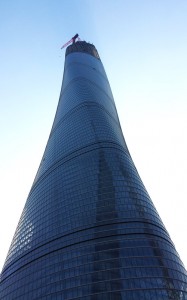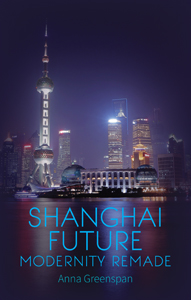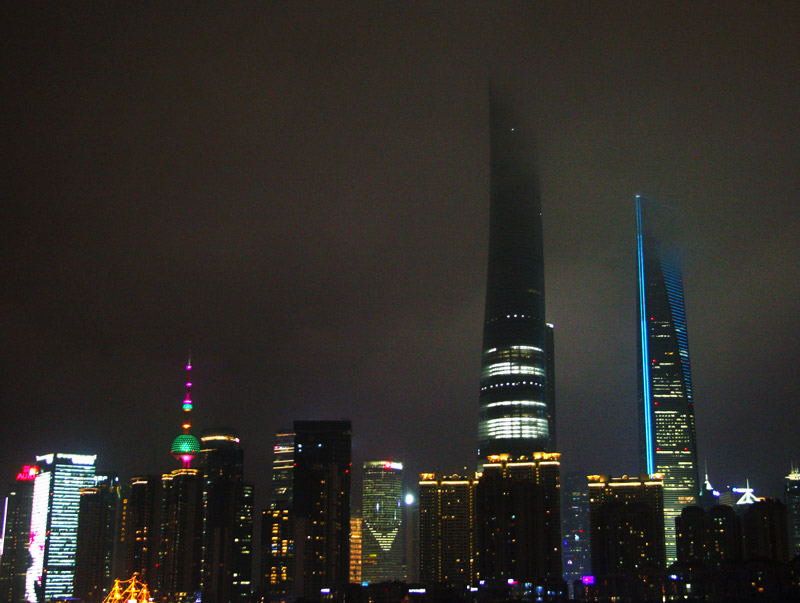On 3 August 2014, Shanghai Tower reached its maximum height of 632 meters and became the tallest tower in China and the second-tallest skyscraper in the world. This latest addition to Shanghai’s urban landscape features an inner core of stacked cylinders wrapped in a spiraling glass skin. Every fourteen floors, giant inner atriums (‘sky gardens’) intersect the double facade providing 360-degree views of the vast metropolis beyond. When the Shanghai Tower opens its doors to the public later this year, it will mark the end of an epoch. The spectacle of Shanghai as the city of the future (already a familiar Hollywood set piece) will—at least as it has thus far been conceived—be complete.
Pudong district, where the skyscraper is located, has supposedly been built to plan; but the truth is more complex. Unlike Haussman’s Paris or New York City as it was carved out by Moses, Pudong never had a single visionary that ruled from on high. Instead, it emerged at just the moment that China’s planned economy opened up to market forces that would inevitably escape its control.
In its earliest conception, the development of Pudong was opened to a high profile international design competition, but, in the end, nobody won. Instead, local companies cobbled together a mishmash of elements from a variety of different proposals into a flexible, mutating urban design. At the center was a cluster of three super-tall skyscrapers, which would provide the iconic grounding for the re-emergence of Shanghai.
The pitch proposed that, together, the three towers represent the unfolding of time. The Jinmao, the earliest tower, which was inspired by the pagoda, symbolises the past; the Shanghai World Finance Center, completed in 2008, marks the present; and the newest tower, the Shanghai Tower, embodies the future.
Mapping the trinity of towers onto a three-fold division of time is a PR trope. Nevertheless, it is hard to escape the feeling that with the completion of the skyscrapers, a certain phase of Shanghai futurism is now over. For the first time in decades there are no public megaprojects on the horizon; no big symbols of growth to look forward to. The countdown clocks, so ubiquitous in city in the lead up to Expo 2010, have all disappeared.
 Shanghai is still oriented towards the future, but its plans—if you can call them that—are far less spectacular and much harder to execute. The city’s new Free Trade Zone is delicately tinkering with economic liberalisation in the hope of creating a financial center to rival Hong Kong. Likewise, Shanghai has ambitions to become a hub of global culture and has built a slew of new museums. But there are doubts that it has the collections, curatorial talent pool and artistic experimentation to match.
Shanghai is still oriented towards the future, but its plans—if you can call them that—are far less spectacular and much harder to execute. The city’s new Free Trade Zone is delicately tinkering with economic liberalisation in the hope of creating a financial center to rival Hong Kong. Likewise, Shanghai has ambitions to become a hub of global culture and has built a slew of new museums. But there are doubts that it has the collections, curatorial talent pool and artistic experimentation to match.
Shanghai futurism, then, is no longer a matter of following a plan that was laid out in the past. Instead, the future has become closer and more unpredictable. This shift echoes the ‘cyberpunk’ transformation in science fiction that occurred in the1980s, epitomised by William Gibson’s first novel, Neuromancer. Awed by the specter of a hyper modern Japan, Gibson set his story in a rising Asian metropolis. Unlike the science fiction that preceded him, the world of tomorrow he imagined was not projected outwards in a far away time and place. Instead, it imploded into the intimacy of cyberspace. ‘The future is already here,’ goes Gibson’s oft repeated phrase, ‘it is just not evenly distributed’.
As the last of Shanghai’s super-towers spirals up from the ground, the city’s era of science fiction comes to a close. Has the age of cyberpunk just begun?
 Anna Greenspan is a Shanghai-based philosopher who focuses on urbanism and digital culture. She teaches at New York University in Shanghai and is the author of Shanghai Future: Modernity Remade.
Anna Greenspan is a Shanghai-based philosopher who focuses on urbanism and digital culture. She teaches at New York University in Shanghai and is the author of Shanghai Future: Modernity Remade.
